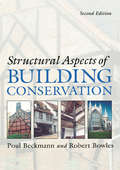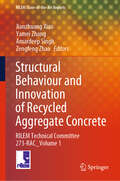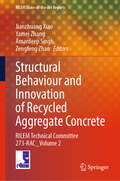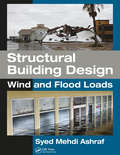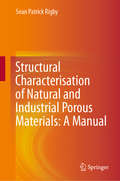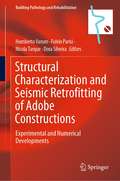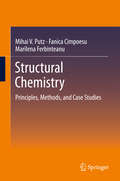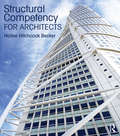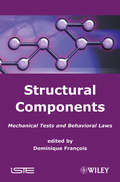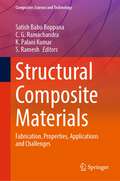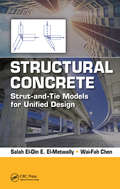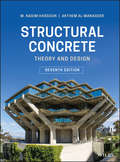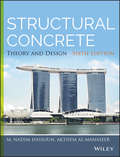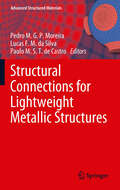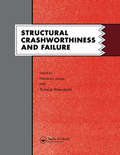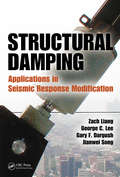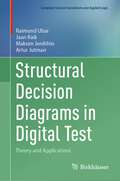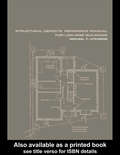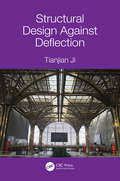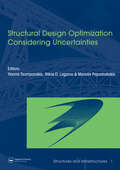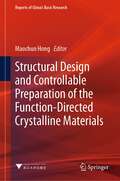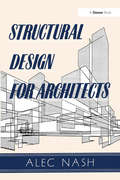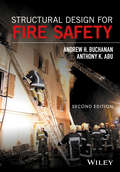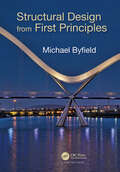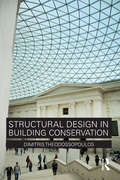- Table View
- List View
Structural Aspects of Building Conservation
by Poul Beckmann Robert BowlesThis practical guide to the assessment and repair of historic buildings is invaluable for structural engineers, architects, surveyors and builders working in all aspects of building conservation. Taking a practical step-by-step approach, the authors discuss the appraisal of buildings and the differences in structural behaviour between new and existing structures. Each stage in the appraisal is explained, using examples from the authors' own work. Each major construction material is assessed in detail, with separate sections on masonry, concrete, timber and the particularly complex issues of iron and steel framed buildings. Techniques for testing the ability of a building to continue its existing use or to be converted to a new use are explained.
Structural Behaviour and Innovation of Recycled Aggregate Concrete: RILEM Technical Committee 273-RAC _ Volume 1 (RILEM State-of-the-Art Reports #41)
by Jianzhuang Xiao Amardeep Singh Yamei Zhang Zengfeng ZhaoThis book presents the work of the RILEM Technical Committee 273-RAC on Structural Behaviour and Innovation of Recycled Aggregate Concrete. It provides the guidelines on the changes in the properties of recycled aggregates and how the different countries manage the use of recycled aggregates in construction work. As such, it helps researchers understand some new technologies to improve the qualities of RAC and the enhancement of RAC. Various mixing approaches adopted by the mixing approach, mixture proportioning for RAC using Compressible Packing Model, Particle Packing Method of mix proportioning for RAC and a rational mix design method for RAC are proposed. Further evaluation of the stress-strain relationship and bond behavior of RAC is explored in these guidelines. The current volume focuses on "Material Properties".
Structural Behaviour and Innovation of Recycled Aggregate Concrete: RILEM Technical Committee 273-RAC_Volume 2 (RILEM State-of-the-Art Reports #42)
by Jianzhuang Xiao Amardeep Singh Yamei Zhang Zengfeng ZhaoThis book presents the work of the RILEM Technical Committee 273-RAC on Structural Behaviour and Innovation of Recycled Aggregate Concrete. It provides the guidelines on the changes in the properties of recycled aggregates and how the different countries manage the use of recycled aggregates in construction work. As such, it helps researchers understand some new technologies to improve the qualities of RAC and the enhancement of RAC. Various mixing approaches adopted by the mixing approach, mixture proportioning for RAC using compressible packing model, particle packing method of mix proportioning for RAC, and a rational mix design method for RAC are proposed. Further evaluation of the stress-strain relationship and bond behaviour of RAC is explored in these guidelines. The current book focuses on "Structural Performance with RAC" and “Codes and Guidelines”. Feel free to contact me with any questions. We are looking forward to hearing from you.
Structural Building Design: Wind and Flood Loads
by Syed Mehdi AshrafStructural Building Design: Wind and Flood Loads is based upon the author’s extensive experience in South Florida as a structural designer, building code official, and an expert witness. He has more than 30 years of engineering experience in the United States, Dubai, and India. The book illustrates the use of ASCE standards ASCE 7-16 and ASCE 24-14 in the calculations of wind and flood loads on building structures. Features: Discussions of the evolution of the ASCE 7 standards Includes discussion of wind load guidance in the International Building Code Examines the Building Envelope Product Approval System Includes numerous solved real-life examples of wind-related issues Presents numerous solved real-life examples demonstrating various flood load concepts
Structural Characterisation of Natural and Industrial Porous Materials: A Manual
by Sean Patrick RigbyThis book focuses on structural characterisation techniques for porous materials. Covering a range of techniques, including gas sorption, mercury porosimetry, thermoporometry, NMR and imaging methods, this practical guide presents the basic theory behind each characterisation technique, and discusses the practicalities of the experimental and data analysis approaches needed for complex industrial samples. The book shows readers how to approach characterising a particular sort of material for the first time and then how to develop a strategy for more in-depth analysis. It also demonstrates how to determine the best techniques for solving particular problems, and describes methods of obtaining the required information, as well as the limitations of various methods. It particularly highlights a scientific approach involving parameter validation and simple acquisition. Featuring examples taken from case studies of real-world industrial materials, this book is intended for industrial practitioners and researchers. It provides a manual of potential techniques and answers questions concerning porous materials that arise in areas such as the catalyst industry, the oil and gas sector, batteries, fuel cells, tissue engineering scaffolds and drug delivery devices.
Structural Characterization and Seismic Retrofitting of Adobe Constructions: Experimental and Numerical Developments (Building Pathology and Rehabilitation #20)
by Humberto Varum Fulvio Parisi Nicola Tarque Dora SilveiraThis book provides the reader with a review of the most relevant research on the structural characterization and seismic retrofitting of adobe construction. It offers a complete review of the latest research developments, and hence the relevance of the field. The book starts with an introductory discussion on adobe construction and its use throughout the world over time, highlighting characteristics and performance of adobe masonry structures as well as different contributions for cultural heritage conservation (Chapter 1). Then, the seismic behaviour of adobe masonry buildings is addressed, including examples of real performance during recent earthquakes (Chapter 2). In the following chapters, key research investigations on seismic response assessment and retrofitting of adobe constructions are reviewed. The review deals with the following issues: mechanical characterization of adobe bricks and adobe masonry (Chapters 3 and 4); quasi-static and shaking table testing of adobe masonry walls and structures (Chapters 5 and 6); non-destructive and minor-destructive testing for characterization of adobe constructions (Chapter 7); seismic strengthening techniques for adobe constructions (Chapter 8); and numerical modelling of adobe structures (Chapter 9). The book ends with Chapter 10, where some general conclusions are drawn and research needs are identified. Each chapter is co-authored by a group of experts from different countries to comprehensively address all issues of adobe constructions from a worldwide perspective. The information covered in this book is fundamental to support civil engineers and architects in the rehabilitation and strengthening of existing adobe constructions and also in the design of new adobe buildings. This information is also of interest to researchers, by providing a summary of existing research and suggesting possible directions for future research efforts.
Structural Chemistry: Principles, Methods, And Case Studies
by Mihai V. Putz Fanica Cimpoesu Marilena FerbinteanuThis book explains key concepts in theoretical chemistry and explores practical applications in structural chemistry. For experimentalists, it highlights concepts that explain the underlying mechanisms of observed phenomena, and at the same time provides theoreticians with explanations of the principles and techniques that are important in property design. Themes covered include conceptual and applied wave functions and density functional theory (DFT) methods, electronegativity and hard and soft (Lewis) acid and base (HSAB) concepts, hybridization and aromaticity, molecular magnetism, spin transition and thermochromism. Offering insights into designing new properties in advanced functional materials, it is a valuable resource for undergraduates of physical chemistry, cluster chemistry and structure/reactivity courses as well as graduates and researchers in the fields of physical chemistry, chemical modeling and functional materials.
Structural Competency for Architects
by Hollee Hitchcock BeckerStructural Competency for Architects is a comprehensive volume covering topics from structural systems and typologies to statics, strength of materials, and component design. The book includes everything you need to know about structures for the design of components, as well as the logic for design of structural patterns, and selection of structural typologies. Organized into six key modules, each chapter includes examples, problems, and labs, along with an answer key available on our website, so that you learn the fundamentals. Structural Competency for Architects will also help you pass your registration examinations.
Structural Components: Mechanical Tests and Behavioral Laws
by Dominique FranÇoisThe mechanical tests presented in this book are essential for determining the basic properties of the materials used. Areas covered include elasticity, tensile and compression tests, hardness, endurance tests and dynamic tests.
Structural Composite Materials: Fabrication, Properties, Applications and Challenges (Composites Science and Technology)
by S. Ramesh Satish Babu Boppana C. G. Ramachandra K. Palani KumarThis book covers topics related to structural composite materials such as processing, characterization, applications and challenges. The book presents ways of processing composites, where different types of composites can be processed depending on the type of reinforcement and matrix. It also outlines the evaluation of mechanical properties of a few processed composites and discusses the potential applications of composites and machining challenges faced in processing polymer and ceramic composites. The book caters to material scientists, industrial practitioners, researchers and students working on structural composite materials.
Structural Concrete: Strut-and-Tie Models for Unified Design
by Salah El-Metwally Wai-Fah ChenThis book examines the application of strut-and-tie models (STM) for the design of structural concrete. It presents state-of-the-art information, from fundamental theories to practical engineering applications, and also provides innovative solutions for many design problems that are not otherwise achievable using the traditional methods.
Structural Concrete: Theory and Design
by M. Nadim Hassoun Akthem Al-ManaseerThe leading structural concrete design reference for over two decades—updated to reflect the latest ACI 318-19 code A go-to resource for structural engineering students and professionals for over twenty years, this newly updated text on concrete structural design and analysis reflects the most recent ACI 318-19 code. It emphasizes student comprehension by presenting design methods alongside relevant codes and standards. It also offers numerous examples (presented using SI units and US-SI conversion factors) and practice problems to guide students through the analysis and design of each type of structural member. New to Structural Concrete: Theory and Design, Seventh Edition are code provisions for transverse reinforcement and shear in wide beams, hanger reinforcement, and bi-directional interaction of one-way shear. This edition also includes the latest information on two-way shear strength, ordinary walls, seismic loads, reinforcement detailing and analysis, and materials requirements. This book covers the historical background of structural concrete; advantages and disadvantages; codes and practice; and design philosophy and concepts. It then launches into a discussion of the properties of reinforced concrete, and continues with chapters on flexural analysis and design; deflection and control of cracking; development length of reinforcing bars; designing with the strut-and-tie method; one-way slabs; axially loaded columns; and more. Updated to align with the new ACI 318-19 code with new code provisions to include: transverse reinforcement and shear in wide beams, hanger reinforcement, bi-directional interaction of one-way shear, and reference to ACI certifications Includes dozens of worked examples that explain the analysis and design of structural members Offers updated information on two-way shear strength, seismic loads, materials requirements, and more Improves the design ability of students by explaining code requirements and restrictions Provides examples in SI units in every chapter as well as conversion factors from customary units to SI Offers instructors access to a solutions manual via the book's companion website Structural Concrete: Theory and Design, Seventh Edition is an excellent text for undergraduate and graduate students in civil and structural engineering programs. It will also benefit concrete designers, structural engineers, and civil engineers focused on structures.
Structural Concrete: Theory and Design
by M. Nadim Hassoun Akthem Al-ManaseerThe most up to date structural concrete text, with the latest ACI revisions Structural Concrete is the bestselling text on concrete structural design and analysis, providing the latest information and clear explanation in an easy to understand style. Newly updated to reflect the latest ACI 318-14 code, this sixth edition emphasizes a conceptual understanding of the subject, and builds the student's body of knowledge by presenting design methods alongside relevant standards and code. Numerous examples and practice problems help readers grasp the real-world application of the industry's best practices, with explanations and insight on the extensive ACI revision. Each chapter features examples using SI units and US-SI conversion factors, and SI unit design tables are included for reference. Exceptional weather-resistance and stability make concrete a preferred construction material for most parts of the world. For civil and structural engineering applications, rebar and steel beams are generally added during casting to provide additional support. Pre-cast concrete is becoming increasingly common, allowing better quality control, the use of special admixtures, and the production of innovative shapes that would be too complex to construct on site. This book provides complete guidance toward all aspects of reinforced concrete design, including the ACI revisions that address these new practices. Review the properties of reinforced concrete, with models for shrink and creep Understand shear, diagonal tension, axial loading, and torsion Learn planning considerations for reinforced beams and strut and tie Design retaining walls, footings, slender columns, stairs, and more The American Concrete Institute updates structural concrete code approximately every three years, and it's critical that students learn the most recent standards and best practices. Structural Concrete provides the most up to date information, with intuitive explanation and detailed guidance.
Structural Connections for Lightweight Metallic Structures
by Lucas F. Silva Paulo M.S.T. Castro Pedro M.G.P. MoreiraIncreasing concern with fuel consumption leads to widespread interest in lightweight structures for transportation vehicles. Several competing technologies are available for the structural connections of these structures, namely welding, mechanical fastening / riveting, and adhesive technologies. Arranged in a single volume, this work is to presents state-of-the-art discussions of those aspects and processes presenting greater novelty whilst simultaneously keeping wide applicability potential and interest. The topics chosen have the common feature of being of currently applied in lightweight structures, and one of the characteristics of this work is bringing together relevant state-of-the-art information usually presented in separate publications specializing in a single technology. The book provides discussions and examples of concrete applications, so that it appeals to researchers and designers and engineers involved in the design and fabrication of lightweight structures.
Structural Crashworthiness and Failure: Proceedings of the Third International Symposium on Structural Crashworthiness held at the University of Liverpool, England, 14-16 April 1993
by Norman Jones Tomasz WierzbickiThis book contains twelve invited lectures from the Third International Symposium on Structural Crashworthiness. Particular emphasis is given to the failure predictions for ductile metal structures under large dynamic loads and to the behaviour of composite and cellular structures.
Structural Damping: Applications in Seismic Response Modification (Advances in Earthquake Engineering #3)
by Zach Liang George C. Lee Gary F. Dargush Jianwei SongRapid advances have been made during the past few decades in earthquake response modification technologies for structures, most notably in base isolation and energy dissipation systems. Many practical applications of various dampers can be found worldwide and, in the United States, damper design has been included in building codes. The current desi
Structural Decision Diagrams in Digital Test: Theory and Applications (Computer Science Foundations and Applied Logic)
by Jaan Raik Raimund Ubar Maksim Jenihhin Artur JutmanThis is the first book that sums up test-related modeling of digital circuits and systems by a new structural-decision-diagrams model. The model represents structural and functional information jointly and opens a new area of research.The book introduces and discusses applications of two types of structural decision diagrams (DDs): low-level, structurally synthesized binary DDs (SSBDDs) and high-level DDs (HLDDs) that enable diagnostic modeling of complex digital circuits and systems.Topics and features:Provides the definition, properties and techniques for synthesis, compression and optimization of SSBDDs and HLDDsProvides numerous working examples that illustrate the key points of the textDescribes applications of SSBDDs and HLDDs for various electronic design automation (EDA) tasks, such as logic-level fault modeling and simulation, multi-valued simulation, timing-critical path identification, and test generationDiscusses the advantages of the proposed model to traditional binary decision diagrams and other traditional design representationsCombines SSBDDs with HLDDs for multi-level representation of digital systems for enabling hierarchical and cross-level solving of complex test-related tasksThis unique book is aimed at researchers working in the fields of computer science and computer engineering, focusing on test, diagnosis and dependability of digital systems. It can also serve as a reference for graduate- and advanced undergraduate-level computer engineering and electronics courses.Three authors are affiliated with the Dept. of Computer Systems at the Tallinn University of Technology, Estonia: Raimund Ubar is a retired Professor, Jaan Raik and Maksim Jenihhin are tenured Professors. Artur Jutman, PhD, is a researcher at the same university and the CEO of Testonica Lab Ltd., Estonia.
Structural Defects Reference Manual for Low-Rise Buildings
by Michael F. AtkinsonThe Structural Defects Reference Manual for Low-Rise Buildings has been written to assist professionals and students involved in building construction to identify causes of structural failure. Each chapter carefully addresses design, materials and workmanship factors which contribute to structural defects. The main structural elements - roofs, wall
Structural Design Against Deflection
by Tianjian JiDeflections tend to have more significance in modern structures, especially those that are either taller, longer or have wider spans than earlier designs. It is also necessary to provide desirable distributions of internal forces in order to achieve effective, efficient and elegant structures. This book presents four structural concepts relating to deflections and internal forces in structures. It demonstrates a number of routes and physical measures together with their implementation for creating desirable distributions of internal forces and for designing structures against deflection. Hand calculation examples, with and without using the implementation measures, are provided to quantify the effectiveness and efficiency of the structural concepts. Practical examples, including several well-known structures, are considered qualitatively to illustrate the practical implementation of the structural concepts and show their structural rationale. The book is especially suitable for advanced undergraduate and graduate students studying civil engineering or architecture and should enhance the holistic comprehension of structural engineers and architects. Features Develops the concepts from their principles through to their implementation Provides worked examples in pairs and analyses real structures Especially suits final year undergraduates and graduate students in structural engineering Author Bio Dr. Tianjian Ji, CEng, FIStructE, FHEA, is Reader in Structural Engineering at the University of Manchester, UK. He received the Award for Excellence in Structural Engineering Education from the Institution of Structural Engineers, UK, in 2014 and the Teaching Excellence Award from the University of Manchester in 2016. He is the primary author of Understanding and Using Structural Concepts, 2nd edition, also published by Taylor & Francis.
Structural Design Optimization Considering Uncertainties: Structures & Infrastructures Book , Vol. 1, Series, Series Editor: Dan M. Frangopol (Structures and Infrastructures)
by Manolis Papadrakakis Nikos D. Lagaros Yiannis TsompanakisUncertainties play a dominant role in the design and optimization of structures and infrastructures. In optimum design of structural systems due to variations of the material, manufacturing variations, variations of the external loads and modelling uncertainty, the parameters of a structure, a structural system and its environment are not given, fi
Structural Design and Controllable Preparation of the Function-Directed Crystalline Materials (Reports of China’s Basic Research)
by Maochun HongThis book presents the findings of a major research program investigating structural design and controllable preparation of function-directed crystalline materials. The program was launched by the National Natural Science Foundation of China during the 11th Five-Year Plan period, which was started in October 2008 and concluded at the end of 2016. This book first summarizes the overall scientific objectives and the current state of the art of crystalline materials research in China and the international frontier. It also focuses on exploring the relationships between structures, compositions, and properties of crystalline materials and proposes new mechanisms and models for new materials exploration. In addition, it introduces a new functional-motif theory that can guide the development of crystalline materials with optical, electrical, and other composite functions and presents new research methods for the controlled synthesis and assembly of crystalline materials, and detection and characterization of functional motifs. Furthermore, practical applications for materials such as photoelectric conversion materials, nonlinear optical materials, laser and fluorescent crystal materials, and ferroelectric and microwave dielectric materials have been described. Given its scope, this book is of interest to researchers who work in crystalline materials. It also promotes the multidisciplinary collaboration among chemistry, materials science, and physics.
Structural Design for Architects
by A NashFirst Published in 2017. An architect is not usually responsible for producing detailed structural calculations and drawings, unless the building concerned is very small and simple. Where the architect can be most effective in the field of structural design is in the clarity of the manner in which suggested solutions, in the form of schematic designs, are put to a structural engineer. It is vital that an architect can propose forms from which the structural engineer need not deviate, to the extent that the original design concept is violated. It is also important that he or she is able to make an informed and rational choice between apparently unrelated structural systems. The theme of this book therefore arises from the necessity for an architect to possess an extensive structural vocabulary, based on a clear understanding of the relevant underlying principles. Although written mainly for practising architects, it is hoped that the book will also provide a fresh perspective on the subject for building surveyors as well as for civil and structural engineers.
Structural Design for Fire Safety
by Andrew H. Buchanan Anthony Kwabena AbuStructural Design for Fire Safety, 2nd edition Andrew H. Buchanan, University of Canterbury, New Zealand Anthony K. Abu, University of Canterbury, New Zealand A practical and informative guide to structural fire engineering This book presents a comprehensive overview of structural fire engineering. An update on the first edition, the book describes new developments in the past ten years, including advanced calculation methods and computer programs. Further additions include: calculation methods for membrane action in floor slabs exposed to fires; a chapter on composite steel-concrete construction; and case studies of structural collapses. The book begins with an introduction to fire safety in buildings, from fire growth and development to the devastating effects of severe fires on large building structures. Methods of calculating fire severity and fire resistance are then described in detail, together with both simple and advanced methods for assessing and designing for structural fire safety in buildings constructed from structural steel, reinforced concrete, or structural timber. Structural Design for Fire Safety, 2nd edition bridges the information gap between fire safety engineers, structural engineers and building officials, and it will be useful for many others including architects, code writers, building designers, and firefighters. Key features: • Updated references to current research, as well as new end-of-chapter questions and worked examples. •Authors experienced in teaching, researching, and applying structural fire engineering in real buildings. • A focus on basic principles rather than specific building code requirements, for an international audience. An essential guide for structural engineers who wish to improve their understanding of buildings exposed to severe fires and an ideal textbook for introductory or advanced courses in structural fire engineering.
Structural Design from First Principles (100 Cases)
by Michael ByfieldThis enlightening textbook for undergraduates on civil engineering degree courses explains structural design from its mechanical principles, showing the speed and simplicity of effective design from first principles. This text presents good approximate solutions to complex design problems, such as "Wembley-Arch" type structures, the design of thin-walled structures, and long-span box girder bridges. Other more code-based textbooks concentrate on relatively simple member design, and avoid some of the most interesting design problems because code compliant solutions are complex. Yet these problems can be addressed by relatively manageable techniques. The methods outlined here enable quick, early stage, "ball-park" design solutions to be considered, and are also useful for checking finite element analysis solutions to complex problems. The conventions used in the book are in accordance with the Eurocodes, especially where they provide convenient solutions that can be easily understood by students. Many of the topics, such as composite beam design, are straight applications of Eurocodes, but with the underlying theory fully explained. The techniques are illustrated through a series of worked examples which develop in complexity, with the more advanced questions forming extended exam type questions. A comprehensive range of fully worked tutorial questions are provided at the end of each section for students to practice in preparation for closed book exams.
Structural Design in Building Conservation
by Dimitris TheodossopoulosNo building is properly conserved if it is not structurally sound. Consequently architects, engineers and conservation officers need an adequate grounding in the technology, the materials and the historic origins of the building in order to complete a conservation project successfully. Structural Design in Building Conservation deals with design issues and technical choices, showing how they are integrated with the planning and architectural outcomes in a conservation project. It brings together theory with current conservation technology, discussing the possibilities of structural details and strategies in architectural expression. Case studies are central to this, and these are organised around such themes as the addition of roofs, requalification of space, strengthening and re-use of fabric, repristination, additions, completions, stiffness adjustments, and the correction of past mistakes. The reader is encouraged to examine the technical details of these real projects, and explore the possible solutions. The philosophy of structural interventions is introduced in the context of conservation theories and practices in various European countries. The main types of strengthening, repairs and interventions are explained using different building types, and the structural nature of the main elements to be strengthened (linear structures, frames, plates and shells) is explored in detail. Case studies included cover a very wide range of historic types and conversions, not only monumental masonry structures like neoclassical buildings, major temples, churches, public buildings and museums, but also more utilitarian structures like historic mills, early reinforced concrete structures and vaulting types. This is essential reading for all students of architectural conservation, and practicing architects and engineers who are involved in conservation projects.
